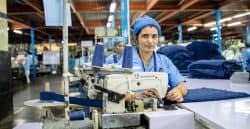An Italian court has placed a Louis Vuitton Moët Hennessy (LVMH) company, Loro Piana, under judicial administration after uncovering forced labor in its luxury cashmere supply chain. Workers, including undocumented migrants, were allegedly subjected to dangerous working conditions, excessive hours, and poverty wages.
Undocumented workers paid about $5 an hour
Investigators found that Loro Piana had subcontracted production to factories operated by Chinese intermediaries in the Milan region. Employers paid workers as little as $5 an hour, forced them to work 90-hour weeks without contracts, and made them sleep in the same facilities where they labored. Additionally, the court noted that the workers “endured exhausting shifts and, in some cases, never even had a regular employment contract.”
The case began after a worker was reportedly assaulted for requesting unpaid wages. As a result, the court has now ordered a one-year period of judicial supervision, meaning a court-appointed commissioner will oversee compliance and reform within the company.
Fifth luxury brand facing forced labor crackdown
Products bearing the Loro Piana label sell for thousands of euros. This is the fifth major fashion brand that Italian courts have placed under supervision for labor exploitation since 2023. Authorities have taken similar action against Armani, Valentino, Alviero Martini, and Dior, all of which used opaque subcontracting chains that relied on exploitative labor. These brands employed undocumented migrant workers in unsafe factory conditions.
Though the court found that the brand failed to prevent forced labor in its supply chain, Loro Piana is not facing criminal charges.
“Forced labor is not a business model”
Reuters reports:
“Loro Piana joins a growing list of luxury brands scrutinized for turning a blind eye to labor conditions in outsourced Italian factories. The ruling reinforces that ‘forced labor is not a business model,’ said one human rights observer.”
Judicial administrators will now be tasked with ensuring ethical compliance. However, labor advocates are pushing for stronger legislation that bans goods linked to forced labor altogether. Court oversight after the fact is not sufficient, they say.
Time to end luxury supply chain exploitation
This case highlights a broader pattern: brands continuing to benefit from labor exploitation behind closed doors. What’s worse is that luxury brands are usually seen as better actors than fast fashion brands. They can afford to treat the people who work on their goods decently. So why don’t they?
Freedom United calls for stronger regulations requiring full supply chain transparency and legal accountability for every tier of production.
We must make it clear: forced labor—whether in fast fashion or high fashion—has no place in any industry.







Freedom United is interested in hearing from our community and welcomes relevant, informed comments, advice, and insights that advance the conversation around our campaigns and advocacy. We value inclusivity and respect within our community. To be approved, your comments should be civil.
What can we do to help?
SHAMEFUL. JUDICIAL REVIEW. IN ITALY. YA, RIGHT.
WHAT ABOUT CONFISCATING LORO PIANA’S STOLEN WAGES FOR THE PAST 5 OR 10 YEARS AND DISTRIBUTING THEM TO THE VICTIMS?
WHAT ABOUT CLOSING THESE FACTORIES DOWN ALTOGETHER, SELLING OFF THIER ASSETS, AND THEN DONATING THE PROCEEDS TO START UPS WHO SIGN A WORKERS RIGHTS PLEDGE?
ILL BET THE “HUMANITY” OF LUXURY BRANDS WOULD IMPROVE.